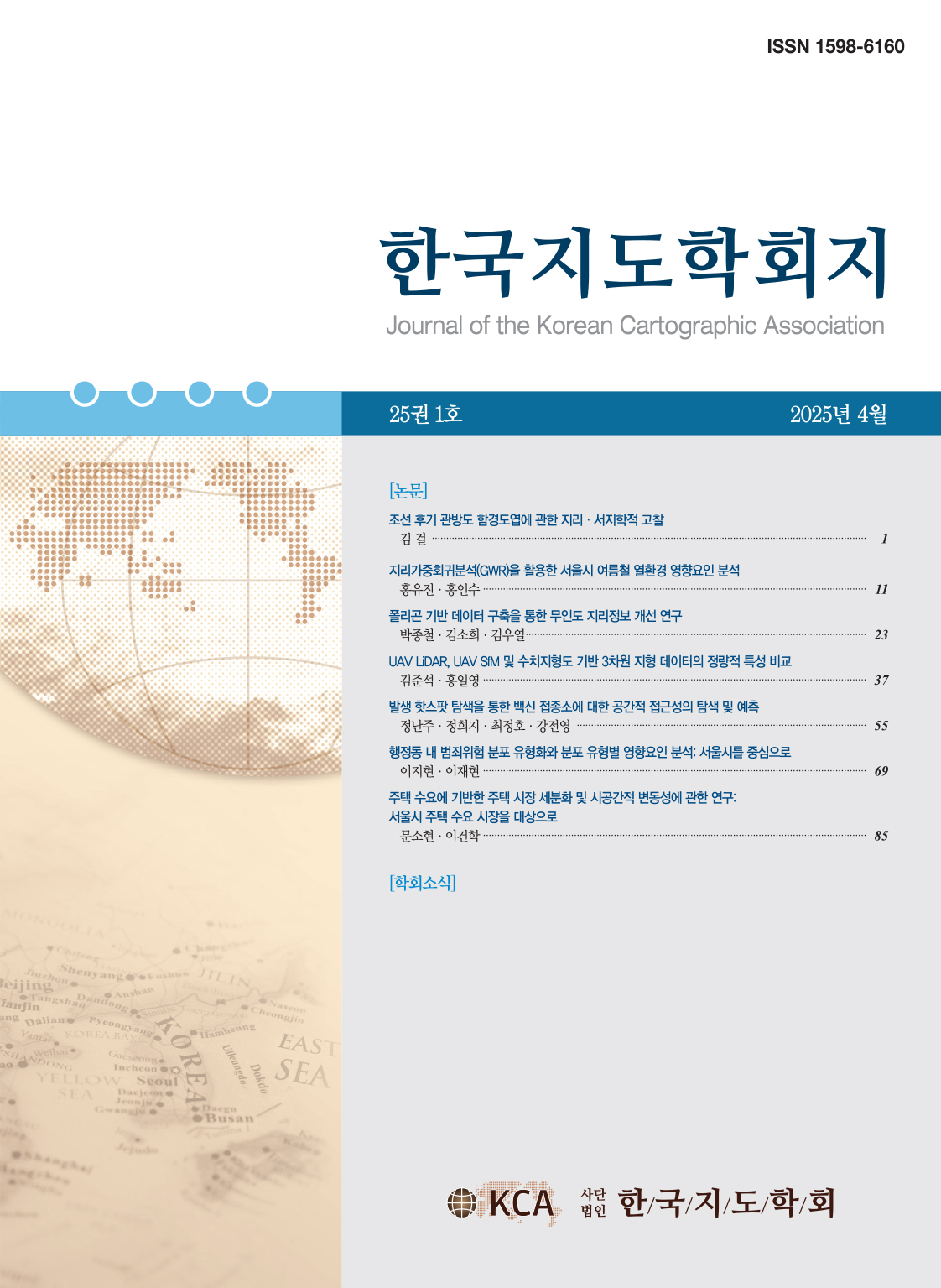Research Article
Abstract
References
Information
As a futuristic transportation system, personal mobility service has experienced rapid increases in service users. Particularly in Seoul, large users naturally led to more traffic accidents. However, relatively few literatures analyzed the traffic accidents because of limited data availability and relatively short service time. This study investigates personal mobility traffic accidents in Seoul in urban socio-environmental perspectives. Negative binomial regression with Eigenvector spatial filtering model is applied to handle spatial autocorrelation in the traffic accident data. Several models are applied, and the best model is derived and analyzed. This study contributes to literature as understanding Seoul’s urban population, transportation, and social index in relation with the personal mobility traffic accidents.
퍼스널 모빌리티는 친환경 1인용 교통수단으로, 공유 서비스 도입 이후 이용자가 급격히 증가하였다. 연관 정책이 미비한 상태에서 이용자가 급증하였고, 이에 따라 서울시를 중심으로 퍼스널 모빌리티 사고가 증가하고 있으나 관련 연구가 부족한 실정이다. 본 연구는 서울시를 중심으로 퍼스널 모빌리티 사고에 영향을 미치는 도시환경 요인을 파악하였다. 사고의 공간자기상관을 제거하기 위해 음이항 회귀모형 및 음이항 아이겐벡터 필터링 모형을 적용하였고, 각 모형을 비교한 후 최적 모형인 음이항 아이겐벡터 필터링 모형의 결과를 바탕으로 사고 결과를 해석하였다. 본 연구는 인구, 교통, 사회 지표를 이용해 퍼스널 모빌리티 사고가 많이 일어나는 서울시 행정동의 특징을 확인하고 분석했다는 점에서 의의를 갖는다.
- 고동원・박승훈, 2019, “공원 주변 환경요인이 보행자 교통사고에 미치는 영향에 관한 연구,” 국토계획, 54(5), 65-75. https://doi.org/10.17208/jkpa.2019.10.54.5.65 10.17208/jkpa.2019.10.54.5.65
- 고민경, 2020, “공유 퍼스널 모빌리티 이용에 따른 도시 경험: 정동적 플랫폼 도시론(affective platform urbanism)을 위한 시론적 연구,” 한국도시지리학회지, 23(3), 35-47. https://doi.org/10.21189/JKUGS.23.3.3 10.21189/JKUGS.23.3.3
- 국토교통부, 2021, 보도자료: 이용자도 보행자도 안전하게, 전동킥보드 관련 규정 강화.
- 곽민정・추상호・김상훈, 2022, “서울시 공공자전거와 공유 전동킥보드의 통행유형별 상호관계 분석: 서초・강남・동작구를 중심으로,” 대한교통학회지, 40(6), 832-846. https://doi.org/10.7470/jkst.2022.40.6.832 10.7470/jkst.2022.40.6.832
- 김나연・주신혜・강희찬・김상훈・송태진, 2022, “개별주행궤적 데이터 기반 전동킥보드 종방향 위험주행상황 식별 방법론 개발,” 대한교통학회지, 40(5), 735-749. https://doi.org/10.7470/jkst.2022.40.5.735 10.7470/jkst.2022.40.5.735
- 김수재・이경재・추상호・김상훈, 2021, “공유 전동킥보드 이용 특성 및 영향요인에 관한 연구,” 한국 ITS 학회 논문지, 20(1), 40-53. https://doi.org/10.12815/kits.2021.20.1.40 10.12815/kits.2021.20.1.40
- 김영호, 2009, “아이겐벡터 공간필터링을 이용한 도시주거범죄의 분석,” 한국경제지리학회지, 12(2), 179-194. 10.23841/egsk.2009.12.2.179
- 김혜진・이현미・이창주・소재현, 2022, “PM 교통사고에 영향을 미치는 근린환경 요인분석 : 로지스틱 회귀모형을 이용하여,” 대한교통학회지, 40(2), 205-217. https://doi.org/10.7470/jkst.2022.40.2.205 10.7470/jkst.2022.40.2.205
- 박철영・이수기, 2016, “가로환경 특성이 보행자 교통사고에 미치는 영향 분석: 가로 세그먼트 분석단위와 공간통계모형의 적용: 가로 세그먼트 분석단위와 공간통계모형의 적용,” 한국도시설계학회지 도시설계, 17(3), 105-121.
- 사경은・서지민・이수기, 2020, “출근시간대 공유자전거 출발・ 도착지 및 최단이동경로 특성 분석-서울시 공유자전거 2017 통행 OD 자료를 중심으로,” 한국도시설계학회지 도시설계, 21(6), 105-120. https://doi.org/10.38195/judik.2020.12.21.6.105 10.38195/judik.2020.12.21.6.105
- 손세린・강영옥, 2017, “서울시 여성운전자 교통사고의 시공간 특성 분석,” 한국지도학회지, 17(2), 89-98. https://doi.org/10.16879/jkca.2017.17.2.089 10.16879/jkca.2017.17.2.089
- 양인범, 2022, “대학캠퍼스 내에서의 퍼스널 모빌리티 이용에 대한 사용자 인식 조사,” 한국산학기술학회 논문지, 23(6), 222-229. https://doi.org/10.5762/KAIS.2022.23.6.222 10.5762/KAIS.2022.23.6.222
- 오창화・김영호, 2016, “공간 회귀와 공간 필터링을 이용한 서울시 젠트리피케이션의 발생 원인 및 특징 분석,” 한국도시지리학회지, 19(3), 71-86. https://doi.org/10.21189/JKUGS.19.3.6 10.21189/JKUGS.19.3.6
- 이기훈・이수기, 2016, “보행자 교통사고 심각도에 영향을 미치는 운전자 연령대별 사고요인 분석,” 한국도시설계학회지 도시설계, 17(3), 63-80.
- 이수일・김승현・김태호, 2017, “개인이동형 교통수단 (PM) 유형별 사고특성 및 위험도 비교연구,” 한국안전학회지(구 산업안전학회지), 32(3), 151-159. https://doi.org/10.14346/JKOSOS.2017.32.3.151 10.3828/eci.2017.11
- 이승민・이건학, 2021, “유동 클러스터 탐지 기법의 개발과 적용: 서울시 대중교통 통행을 사례로,” 한국지도학회지, 21(2), 219-144. https://doi.org/10.16879/jkca.2021.21.2.129 10.16879/jkca.2021.21.2.129
- 임창민・김영호, 2016, “아이겐벡터 공간필터링 모형을 활용한 국내 결핵발생의 사회ㆍ 환경적 결정 요인 분석,” 한국지도학회지, 16(3), 89-101. https://doi.org/10.16879/jkca.2016.16.3.089 10.16879/jkca.2016.16.3.089
- 장재민・김태형・이무영, 2016, “서울시 공공자전거 이용특성에 관한 연구: 여의도 및 상암 지구를 사례로,” 서울도시연구, 17(4), 77-91. https://doi.org/10.23129/seouls.17.4.201612.77 10.23129/seouls.17.4.201612.77
- 최민혜・정헌영, 2020, “Personal Mobility 공유서비스 이용의향에 미치는 영향요인에 관한 연구,” 대한교통학회지, 38(1), 1-13. https://doi.org/10.7470/jkst.2020.38.1.001 10.7470/jkst.2020.38.1.001
- 한다정・김응철・지민경, 2020, “PM(Personal mobility) 교통사고의 심각도 요인 분석,” 대한교통학회지, 38(3), 232-247. https://doi.org/10.7470/jkst.2020.38.3.232 10.7470/jkst.2020.38.3.232
- 한상연・이철기・윤일수・윤여일・나재필, 2021, “PM(Personal Mobility) 교통사고 특성 및 사망사고 발생 요인 분석,” 한국 ITS 학회 논문지, 20(1), 100-118. https://doi.org/10.12815/kits.2021.20.1.40 10.12815/kits.2021.20.1.40
- 한재원・안수영・김미성・한동형・이수기, 2022, “서울시 Personal Mobility 우선 공급 지역 분석: First-Last Mile 통행특성을 중심으로,” 국토계획, 57(1), 42-56. https://doi.org/10.17208/jkpa.2022.02.57.1.42 10.17208/jkpa.2022.02.57.1.42
- 홍종선・김명진, 2010, “자전거 교통사고의 통계분석 및 활용,” 한국데이터정보과학회지, 21(6), 1081-1090.
- 황선근・이수기, 2021, “서울시 자전거 교통사고의 물리적 환경요인 분석,” 국토계획, 56(5), 83-96. https://doi.org/10.17208/jkpa.2021.10.56.5.83 10.17208/jkpa.2021.10.56.5.83
- Anselin, L. and Bera, A.K., 1998, Spatial dependence in linear regression models with an introduction to spatial econometrics, Statistics textbooks and monographs, 155, 237-290.
- Barr, S., 2018, Personal mobility and climate change, Wiley Interdisciplinary Reviews: Climate Change, 9(5), e542. https://doi.org/10.1002/wcc.542 10.1002/wcc.542
- Cliff, A.D. and Ord, J.K., 1973, Spatial autocorrelation, Pion, London.
- Dormann, C.F., Mcpherson, J.M., Araujo, M.B., Bivand, R., Bolliger, J., Carl, G., Davies, R.G., Hirzel, A., Jetz, W., Kissling, W.D., Kuhn, I., Ohlemuller, R., Peres-Neto, P., Bjorn, R., Schröder, B., Schurr, F. M., and Wilson, R., 2007, Methods to account for spatial autocorrelation in the analysis of species distributional data: a review, Ecography, 30, 609-628. https://doi.org/10.1111/j.2007.0906-7590.05171.x 10.1111/j.2007.0906-7590.05171.x
- Griffith, D., Chun, Y., and Li, B., 2019, Spatial regression analysis using eigenvector spatial filtering, Academic Press. 10.1007/978-3-642-36203-3_72-1PMC6661724
- Griffith, D.A., 2003, Spatial filtering, Springer. 10.1007/978-3-540-24806-4_4
- Griffith, D.A., 2012, Advanced spatial statistics: special topics in the exploration of quantitative spatial data series (Vol. 12), Springer Science & Business Media.
- Griffith, D.A. and Haining, R., 2006, Beyond mule kicks: The Poisson distribution in geographical analysis, Geographical Analysis, 38(2), 123-139. https://doi.org/10.1111/j.0016-7363.2006.00679.x 10.1111/j.0016-7363.2006.00679.x
- Hilbe, J.M., 2011, Negative binomial regression, Cambridge University Press. 10.1017/CBO9780511973420
- Oh, J. and Kim, J., 2021, Where to ride? An explorative study to investigate potential risk factors of personal mobility accidents, International journal of environmental research and public health, 18(3), 965. https://doi.org/10.3390/ijerph18030965 10.3390/ijerph1803096533499255PMC7908115
- Thayn, J.B. and Simanis, J.M., 2013, Accounting for spatial autocorrelation in linear regression models using spatial filtering with eigenvectors, Annals of the Association of American Geographers, 103(1), 47-66. https://doi.org/10.1080/00045608.2012.685048 10.1080/00045608.2012.685048
- Xie, Z. and Yan, J., 2008, Kernel density estimation of traffic accidents in a network space, Computers, environment and urban systems, 32(5), 396-406. https://doi.org/10.1016/j.compenvurbsys.2008.05.001 10.1016/j.compenvurbsys.2008.05.001
- 교통사고분석시스템, taas.koroad.or.kr
- 서울 열린데이터광장, data.seoul.go.kr
- 서울시 교통정보 시스템, “2021 서울특별시 교통량 조사자료”, https://topis.seoul.go.kr/refRoom/openRefRoom_2.do (2023.4 검색)
- Gbike Co., 2020, 지쿠(버전 2.264) 모바일 앱, 구글 플레이 스토어, https://play.google.com/store/apps/details?id=io.gbike.gcooter
- PUMP, 2019, 씽씽 - 새로운 이동생활(버전 4.3.0) 모바일 앱, 구글 플레이 스토어, https://play.google.com/store/apps/details?id=com.xingxingapp
- Ride Beam, 2018, 빔 | Beam - 새로워진 도시 흐름(버전 2.5.6) 모바일 앱, 구글 플레이 스토어, https://play.google.com/store/apps/details?id=com.escooterapp
- Publisher :The Korean Cartographic Association
- Publisher(Ko) :한국지도학회
- Journal Title :Journal of the Korean Cartographic Association
- Journal Title(Ko) :한국지도학회지
- Volume : 24
- No :1
- Pages :97~110
- DOI :https://doi.org/10.16879/jkca.2024.24.1.097



 Journal of the Korean Cartographic Association
Journal of the Korean Cartographic Association





